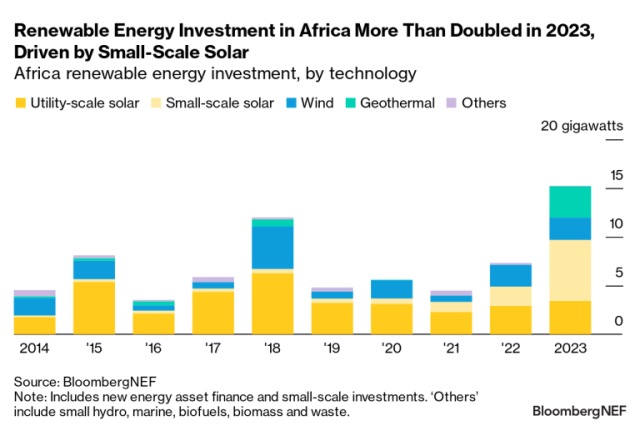The African Union has set a target to bring 300 gigawatts (GW) of renewable energy online by 2030, more than quadrupling the 72 GW installed across the continent last year.
BloombergNEF (BNEF) report said this goal will require annual renewable energy deployments to increase from 8 GW today to 32.5 GW per year for the rest of the decade.
While Africa’s installed renewable energy capacity has doubled over the past decade, neither current country-level targets nor BNEF’s forecasts align with the African Union’s 300 GW goal. BNEF’s 2030 forecast for wind and solar additions falls 43 percent short of the required build, and even the most ambitious country-level targets fall short by 35 percent. This signals a significant gap between goals and delivery as the continent strives to meet both decarbonization and energy access objectives.
However, there are reasons for optimism. African markets achieved a record year for renewable energy investment in 2023, with $15 billion tracked by BNEF, more than double the previous year’s total. While this represents just 2.3 percent of global renewable investment, it still reflects improving investment conditions in key African markets. Over half of this investment was driven by utility-scale wind, solar, and geothermal projects reaching financial closure in countries like Egypt, Morocco, Kenya, Niger, and South Africa.
Africa renewable energy capacity BNEF
A standout growth driver in 2023 was small-scale solar, which saw its investment more than triple to $6.3 billion, contributing 41 percent of the continent’s total renewable energy investment. South Africa played a key role, with small-scale solar growing fivefold due to policy changes, including the removal of generator licensing thresholds and the introduction of tax incentives for businesses investing in renewables. Nigeria and Morocco also made significant strides, with Nigeria’s removal of a gasoline subsidy boosting interest in solar as a cost-effective alternative to private generators.
Africa is adding renewable energy capacity faster than fossil fuels. In 2023, the continent added 7.9 GW of renewable capacity — more than triple the net additions of fossil fuels. Importantly, net fossil-fuel capacity additions have fallen to an average of 3 GW annually over the past five years, a 70 percent drop compared to the previous five years. Despite this progress, coal and gas still account for two-thirds of Africa’s annual power generation, and much of the fossil-fuel infrastructure is relatively new, built to meet growing electricity demand.
The challenge goes beyond expanding renewables—only a few African countries are driving large-scale renewable energy capacity additions. South Africa, Morocco, and Egypt currently account for more than two-thirds of the continent’s installed wind and solar capacity, and they remain pivotal in future growth.
Emma Champion, Head of Regional Energy Transitions at BloombergNEF and lead author of the report, warned that “many markets still lack a clear route-to-market for developers to build large-scale projects.” Less than 60 percent of African countries have established auction or tender programs for renewable energy, and even fewer award contracts consistently. Without clear policies and a supportive environment, Africa’s 2030 ambitions risk being derailed.
Source link : https://greentechlead.com/renewable-energy/africa-to-quadruple-renewable-energy-capacity-faces-delivery-gap-47948
Author :
Publish date : 2024-10-05 02:06:35
Copyright for syndicated content belongs to the linked Source.
